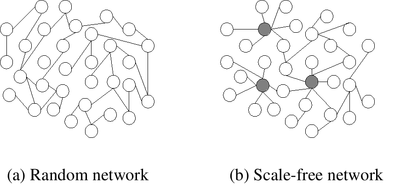On Modeling Shortest Path Length Distribution in Scale-Free Network Topologies
Objective
The objective of this project is, demonstrates, for the first time, that it is possible to create simple and effective Gaussian based models of the shortest path distribution in scale-free network topologies by accounting for the number of nodes only. The accuracy of the proposed models has been further investigated by considering real Internet network topologies, learned from reference data sets.
Abstract
In the on modelling shortest path length distribution in scale-free network project, Complex and interconnected systems belonging to biological, social, economic, and technology application fields are generally described through scale-free topology models. In this context, it is essential to characterize the distribution of shortest paths in order to obtain precious insights on the network behaviour. Unfortunately, the few contributions available in the current scientific literature require a case-by-case tuning of model parameters. To bridge this gap, novel Gaussian-based models are proposed hereby, whose parameters can be immediately tuned based on the number of nodes (N) composing the network, only.
In this way, given N, it becomes possible to predict the distribution of shortest paths without retuning the model for each scenario of interest. The outcomes of the proposed models have been successfully validated and compared with respect to state-of-the art approaches in a wide set of network topologies. To provide a further insight, the conceived Gaussian-based models have been also evaluated for real Internet topologies, learned from reference data sets. Obtained results highlight that the proposed models are able to reach a good trade-off between the level of accuracy and complexity, even for real network configurations.
Keywords: Analytical Model,
Internet Topology, Network Theory (Graphs), Shortest Path Problem,
Telecommunication Network Topology
NOTE: Without the concern of our team, please don't submit to the college. This Abstract varies based on student requirements.
Block Diagram

Specifications
HARDWARE SPECIFICATIONS:
System: Pentium IV 2.4 GHz.
Hard Disk: 40 GB.
Floppy Drive: 1.44 Mb.
Monitor: 15 VGA Colour.
Mouse : Logitech.
Ram: 512 Mb.
SOFTWARE SPECIFICATIONS:
Operating system: Windows XP/7/LINUX.
Implementation: NS2
NS2 Version: NS2.2.34
Front End: OTCL (Object Oriented Tool Command Language)
Tool: Fedora (To simulate in Linux OS)
Learning Outcomes
- What is Tomcat server and how they can work?
- What is Internet Topology?
- What is Network Theory?
- What is Analytical Model?
- What is shortest path problem?
- What type of technology versions is used?
- Data Parsing Front-End to Back-End.
- Need of Eclipse-IDE to develop a web application.
- Working Procedure.
- Testing Techniques.
- Error Correction mechanisms.
- How to run and deploy the applications?
- Introduction to basic technologies used for.
- How project works?
- Input and Output modules.
- How to test the project based on user inputs and observe the output?
- Practical exposure to software tools and solution providing for real time problems working with team/ individual work on Creative ideas.
- Learn about types of algorithms and how to use?
- Project Development Skills:
- Problem analysing skills.
- Problem solving skills.
- Creativity and imaginary skills.
- Programming skills.
- Deployment.
- Testing skills.
- Debugging skills.
- Project presentation skills.
- Thesis writing skills.





 Paper Publishing
Paper Publishing
